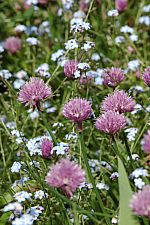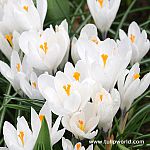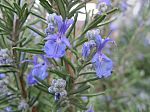For much more detail of the best flowers to grow for pollinators, check out my book "Gardening for Bumblebees", published 2021.
You can buy Gardening for Bumblebees here
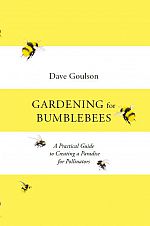
Many flowers are attractive to bees, with different types of bee varying in their particular preferences. In particular, long-tongued bumblebees such as Bombus hortorum tend to favour deep flowers, and of course short-tongued bumblebees such as Bombus terrestris prefer shallow flowers. Sometimes short-tongued bees rob deep flowers by biting a hole in the side of the flower so they can reach the nectar.
In general herbs and cottage garden perennials are good, and annual bedding plants are best avoided (because they have been intensively bred and have often lost their rewards or become so mishapen that insects cannot get in to them - also, many have been drenched in insecticides).
This is an incomplete list of some of my favourites, all guaranteed to attract bumblebees to your garden. Star ratings are from 1 to 5, and reflect my view of how attractive they are to bees. All are worth growing!
Do let me know if you have particular proven favourites that I have missed - ideally, send me a picture!
You can learn more about garden flowers for bees, and take a tour of my garden, on my Youtube channel
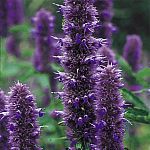 |
Agastache***** A great plant for bees, originally from North America. I have found it very hard to get seeds to germinate, and plants have a habit of dying over the winter, so generallty not for the beginner! However, the bees to love it. Variety Blackadder seems good. |
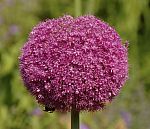 |
Allium *** Many garden varieties are available, these are bulb forming perennials. Some are very showy, with huge flower heads. Note that chives also belong to this genus, but they are mentioned seperately below. |
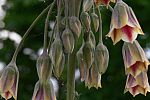 |
Allium siculum, Sicilian honey garlic *** Worth a special mention amongst the alliums, these odd-looking plants drip with nectar and are exceedingly popular with bees, especially red-tailed bumblebees. |
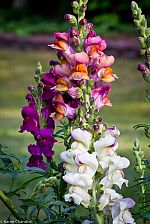 |
Antirrhinum, snapdragon* Like their relative the foxglove, mainly visited by long-tongued bumblebees such as B. hortorum. Short-lived perennials, often grown as annuals. |
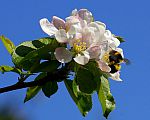 |
Apple ** Apples are a good source of forage for queens in April and May, and of course the bee visits ensure a good crop. All varieties are good, but some of the crab apples produce particularly profuse flowers and are very attractive. I have 24 varieties of apple in my garden :) |
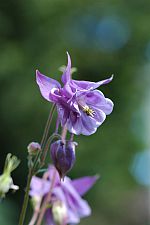 |
Aquilegia *** A lovely herbaceous plant, flowers in spring. Nectar is hidden at the end of very long tubes, so it is visited by long-tongued bees - mainly Bombus hortorum - but also robbed by short-tongued bees such as B. terrestris. Tolerates shade, and usually self-seeds, every garden should have some. |
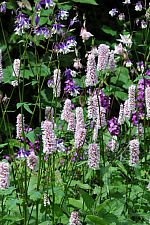 |
Bistort ** A very tough, spreading, low growing perennial. Good ground cover. A bit hit and miss with bees, but seems popular with Bombus hypnorum in particular. |
|
|
Borage**** Great plant for short tongued bumblebees and honeybees, an easy to grow annual that flowers for months and is very rich in sweet nectar. The petals can also be used to make salads more beautiful. |
 |
Buddliea davidii, Butterfly Bush*** A fast growing shrub, to 9', great nectar source for butterflies and popular too with bumblebees. I often see young queen Bombus terrestris on this, fattening up before going into hibernation in July/August. |
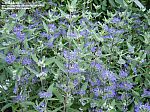 |
Caryopteris x clandonensis** A large, bushy perennial growing to 4', profuse mauve flowers |
|
|
Chives *** A very easy to grow herb, lovely in omlettes and with new potatoes, and much loved by short-tongued bees. Self-seeds like crazy, so watch out! |
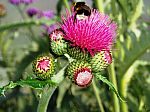 |
Cirsium rivulare*** A great one for male bumblebees in high summer, this species is not spiny like its wild relatives and is quite at home in a herbaceous border. However, it does spread vegetatively and can take over a bit. Propagate from seed or root cuttings. Flowers July-Sept, up to 3' high. |
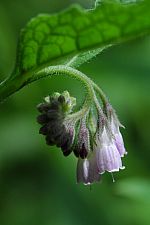 |
Comfrey, Symphytum officinale ***** A very hardy perennial, great for the back of a herbaceous border. Very long flowering period, from May to August, and one of the very best plants for bees. Visited by long and short-tongued species, the latter often robbing from holes bitten in the tops of the flowers. Comfrey can also be chopped down regularly and used to make excellent compost. Can grow 5' tall or more, and will smother smaller plants nearby. Doesn't seed readily, but easily propagated is you have one plant by digging it up in winter and splitting the roots into multiple chunks. My garden is full of it, so if you want some and live near E Sussex I can supply a root or two for free. |
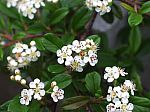 |
Cotoneaster horizontalis** Favoured by short-tongued species such as the early bumblebee, B. pratorum and the tree bumblebee, B. hypnorum. Flowers in late spring, also provides red berries for birds in winter. A low-growing, spreading shrub, very hardy. |
|
|
Crocus** Great for queens when just emerged from hibernation. Joan of Arc comes highly recommended. |
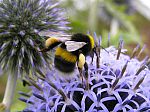 |
Echinops, Globe thistle*** Pretty and unusual perennial, with mauve flowers producing spiky balls on tall stury stems in high summer. |
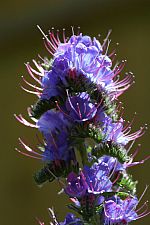 |
Echium vulgare, Viper's bugloss***** A stunning biennial wildflower growing to about 4', flowering in July and August and absolutely loved by bees of all types for its copious nectar. Likes a sunny, well-drained site, and given this will freely self-seed.
|
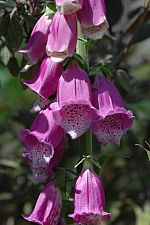 |
Foxglove, Digitalis purpurea *** No cottage garden is complete without foxgloves, hardy biennials that are loved by long-tongued bees such as B. hortorum and B. pascuorum. Tolerate shade well, but flower best in full sun. Freely self-seeds. |
 |
Geranium spp. ** Not to be confused with the gaudy Pelargonium, geraniums are hardy perennials that come in a broad range of colours, but most are moderately attractive to short-tongued bees. The wild Geranium pratense is shown. They are great for ground cover in the front of a border. Geranium sanguinea also good, and the cultivated forms 'Patricia' and 'Ann Folkard'. |
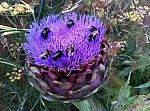 |
Globe artichoke**** Huge plants, related to thistles, with massive composite flowers that bees flock to in July/August. Grows to 6' or more. You can of course also harvest and eat the buds, but try to leave some for the bees! A favourite with male bumbles. |
 |
Heathers, Erica spp. *** The spring-flowering garden varieties are particularly popular with early-emerging queen bumblebees, some flowering as early as February when little else is available. The summer-flowering native species are less valuable in a garden setting, though in the wild they are important foodplants for heathland bumblebee species. |
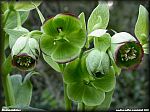 |
Helleborus foetidus ** Flower in late winter, great for early emerging queens. Unusual looking herbaceous plants, usually less than 1' tall. |
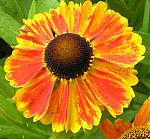 |
Hellenium *** A new discovery for me, Helenium's seem very popular with bees of all sizes, but particularly with some of the smaller solitary bees. Seems prone to dying off in the winter in my soggy clay garden. Many varieties are available, if anyone finds out which ones are best for bees please let me know. I am assured that Moerheim Beauty is excellent. |
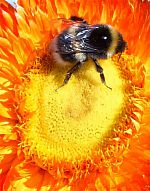 |
Helianthis, Sunflower*** Iconic, very tall annuals, producing spectacular dinner-plate sized flowers that attract many insects, including bumblebees, honeybees and hoverflies. |
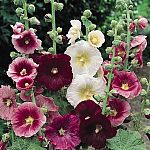 |
Hollyhock*** A classic cottage garden plant, giant biennials growing to 10' tall, very popular with male Bombus terrestris. Bees seem to go for the nectar but ignore the plentiful pollen, often becoming smothered in it. Needs staking or growing in dense clumps. |
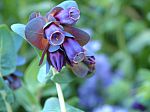 |
Honeywort, Cerinthe major**** An unusual annual, preferring sunny locations. Produces huge amounts of nectar, but I've always found it hard to keep this plant going in my garden. |
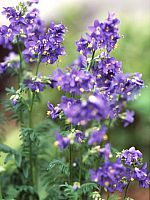 |
Jacob's ladder, Polemonium caeruleum** Very pretty little perennial, up to 2' tall, and often overlooked as a plant for bees. Easy to grow perennial, tolerates most conditions, flowers in May-June. |
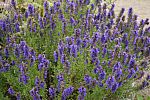 |
Hyssop, Hyssopus officinale ** An understated, low-growing perennial herb, can also be used in cooking though not to my taste - I prefer to leave it to the bees! |
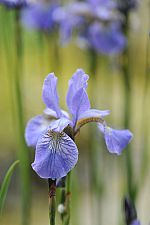 |
Iris (Iridaceae). There are many species of iris grown in gardens - generally with spectacular flowers that are good for bees. Yellow flag iris that grows in ponds is also good. I'd welcoem suggestions for particular varieties that are best for bees. |
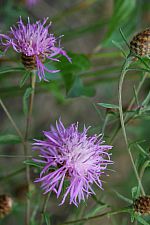 |
Knapweed, Centaurea nigra and Centaurea major *** A common meadow wildflower, but takes well to the herbaceous border. Flowers July-August, partticularly favoured as drinking posts for male bumblebees. |
 |
Lavender **** Everybody's favourite, including the bees. A long-lived, hardy perennial (although susceptible to hard frosts in the far north of the UK). Flowers in July and August, and guarantees a cloud of bees. A bit tricky to propogate from seed, can be grown from cuttings. Dutch lavender, Lavandula x intermedia is the best species for bee visits, and variety Gros Bleu performed best of all in trials by Michael Garbuzov at Sussex University. |
 |
Limnanthes, Poached Egg Plant** Not one I have tried myself, but it comes strongly recommended |
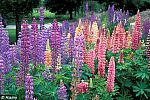 |
Lupin** Lovely traditional cottage garden short-lived herbaceous perrenial, easy to propagate from seed. Most varieties produce little nectar, but bees like the bright orange pollen. An invasive weed in Scandinavia, but does not seem to be a problem in UK. |
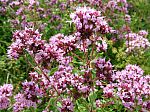 |
Marjoram, Origanum vulgare***** A great all rounder, easy to grow, attractive to heaps of different pollinators, and good for cooking too! Perennial, self-seeds, growing to ~2' tall, loves a sunny position. An essential plant for every garden. |
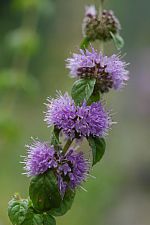 |
Mint, Mentha spp. ** There are several wild species in the UK, and many garden varieties. Water mint is great for ponds, and is one of the most attractive for bees. Most flower July-September. Very easy to grow, but can be invasive, so best planted into containers. |
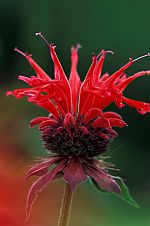 |
Monarda, Bee balm*** An elegant, showy herbaceous plant, native to North America. |
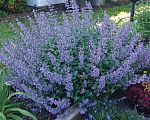 |
Catmint**** A fantastic cottage garden classic, extremely popular with bumblebees, and flowering for a long period from early summer to autumn. Very easy to grow, every garden should have some. Hills Giant is one of the best varieties for bees. |
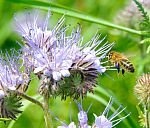 |
Phacelia tanacetifolia***** Perhaps the single most attractive plant for bees on the planet! An easy-to-grow annual, flowers in 8-10 weeks from sowing and keeps flowerring for quite a while. Incredibly nectar rich, bees go crazy for it. A North American native, easy to grow from seed. Sometimes sold as a green manure. |
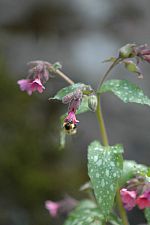 |
Pulmonaria, lungwort *** A great early spring nectar resource for hungry queen bumblebees, visited by long-tongued species, especially Bombus pascuorum. An easy perennial, best near the front of a border. |
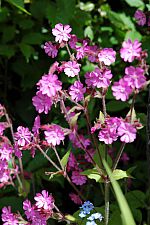 |
Red Campion * A lovely perennial wildflower with a very long flowering period, from May to September. Visited by Bombus hortorum. Readily seeds, and tolerates shade. Plants are either male or female. |
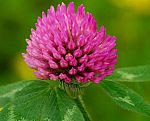 |
Red clover** A staple of bumblebees in the wild, red clover used to be a very common UK plant. Doesn't make much of a border plant, but great naturalized in meadow areas. Favoured by long-tongued bumblebees |
|
|
Rosemary** An odd plant in that it flowers almost all year round, including the depths of winter. Can be a welcome food for early spring queens and also Bombylius bee flies. Very useful in cooking too! |
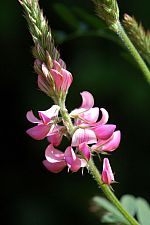 |
Sainfoin *** A rare perennial wildflower in the UK, I have only seed it on Salisbury Plain. Occasionally grown as a fodder crop. Stunning pink flowers, and like most legumes, popular with bees. |
 |
Salix spp., Sallow / pussy willow **** Trees, some growing to 30' or more. Sallows are dioecious, being either male or female. Both produce catkins in early spring, and are very important sources of food for queens. The males produce pollen and a little nectar, the females only nectar. Dwarf varieties can be bought for smaller gardens. |
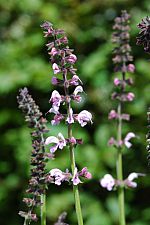 |
Salvia spp., Meadow Clary ** Many garden salvias are available, but I love the wild Meadow Clary, a rare meadow plant. Worth growing just to observe thepollination mechanism; when a bee probes for nectar, this triggers the stamens to curl down and deposit of blob of pollen onto the bee's back. The garden herb sage (Salvia officinalis) is also popular with long-tongued bees. |
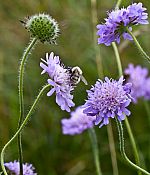 |
Scabious, Knautia spp. **** Lovely meadow perennial, one of my particular favourites. Our wild Knautia arvensis is found on chalk downland. There are many garden strains and species. I love the powder-puff blue of the flowers, and bees seem pretty keen too! Flowers in July and August.
|
 |
Sedum spectabile*** A succulent herbaceous perennial, flowering in September, and loved by male bumblebees and butterflies. Grows to about 1', can be spread by splitting plants. |
 |
Sidalcea Related to hollyhock and mallows, I have not tried Sidalcea but it comes highly recommended. One to try.
|
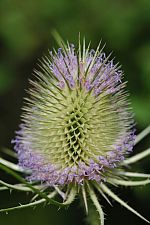 |
Teasel, Dipsacus fullonum **** A biennial wildflower, grows very tall (over 6') and rather spiky. However, makes a tremendous plant for the back of a border, the dead flower stems also provide great structure through the winter. Self seeds. Very popular with a broad range of bee species. Flowers July-August. |
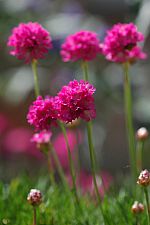 |
Thrift ** A lovely low-growing perennial plant found in the wild on rocky coastal headlands. Flowers in may and june. One for the rockery or in pots. |
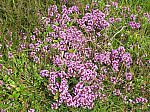 |
Thyme**** There are a number of wild and cultivated species. Thymus polytrichus subsp. britannicus is said to be wonderful for bumblebees. Thymes also attract hoverflies and hobeybees in abundance. A lovely, low-growing, rambling plant for a pot, the cracks in a patio, or the front of a border. |
 |
Tufted vetch, Vicia cracca **** A scrambling climber, a wildflower that takes well to the garden, and great for long-tongued bumblebees. Popular with the very rare Bombus distinguendus if you happen to live in the Hebrides or Orkney! |
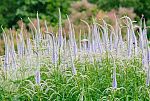 |
Veronicastrum virginicum*** Not one I have tried, but it comes highly recommended. Lovely elegant spires of flowers. |
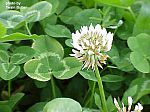 |
White clover** Not a spectacular plant, but lovely in a lawn so long as it isn't mown too often. Can be grown instead of grass as an alternative lawn covering. My lawn is full of it :) |
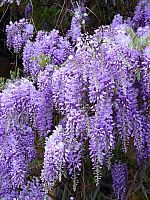 |
Wisteria*** How can you not love wisteria? One of the most beautiful plants, with cascading tresses of purple flowers in spring. A legume, hence related to peas and clovers, a family much loved by bees for their protein-rich pollen. A woody climber, stunning trained along a south-facing wall or over a pergola. If you are a multi-millionaire, buy a period stone manor house in the Cotswolds to grow one up :) |
Viper's bugloss




